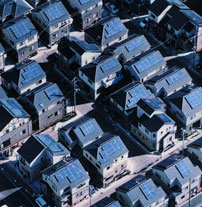Rooftop solar has been growing so rapidly in the US over the past few years that the Center of American Progress (CAP) asked, "Who is buying all that solar?"
While wealthy people helped by being early adopters, the middle class is driving widespread installation, concludes CAP.
In fact, rooftop solar installations are overwhelmingly located in middle-class neighborhoods where median incomes range from $40,000 to $90,000.

They analyzed data from Arizona, California, and New Jersey from 2011-2012 – states that lead on solar deployment. It turns out that in Arizona and California, solar is growing the fastest in neighborhoods where median incomes are $40,000 to $50,000, and even lower in New Jersey – $30,000 to $40,000.
This counters what many utilities say these days – that low and middle income customers that can’t afford solar are subsidizing wealthy people who can. Those who sell electricity back to the grid through net-metering should pay a special, monthly charge or else everyone else pays for a utility’s grid services, except them.
In at least six states – Arizona, California, Colorado, Idaho, Louisiana and Vermont – utilities are trying to scale back net-metering policies that pay homeowners and businesses for the energy they send to the grid.
"Net metering operates much like a regressive tax, where the customers who cannot afford to install solar generation pay more to subsidize those customers who are able to afford an investment in solar," commented Ronald Gerwatowski, senior vice president of National Grid, regarding Massachusetts’ proposal to raise the solar carve-out in its Renewable Portfolio Standard.
"The oft-repeated utility-industry narrative is not only being used as a vehicle for solar policy scrutiny – it also serves as a distraction from the fact that solar technology provides the same benefits to the grid regardless of the homeowner’s income level," says CAP.
"These benefits include avoided fuel costs, reduced transmission and distribution costs, emissions-free energy production, and generation capacity that can offset use during peak energy-consumption times during the day in certain regions. Some utilities have quantified those benefits and found that the value that solar technology brings to the grid in their service territory is actually higher than the retail electricity rate."
Read, Solar Power to the People: The Rise of Rooftop Solar Among the Middle Class:
